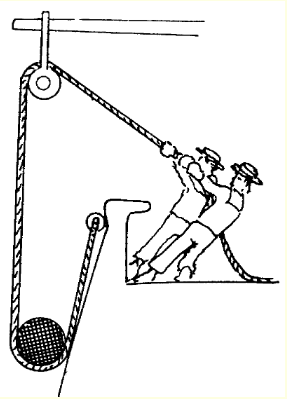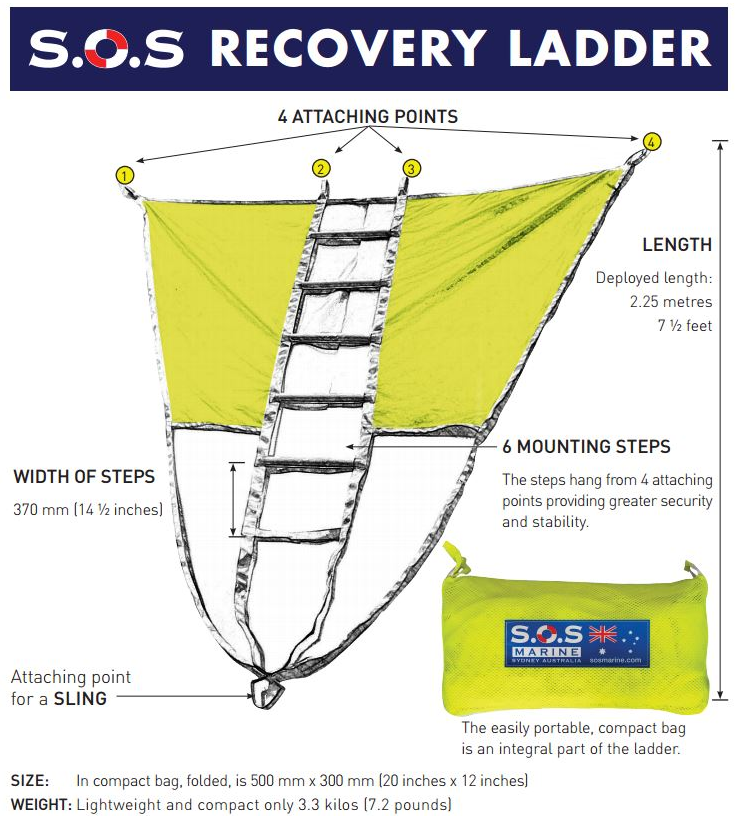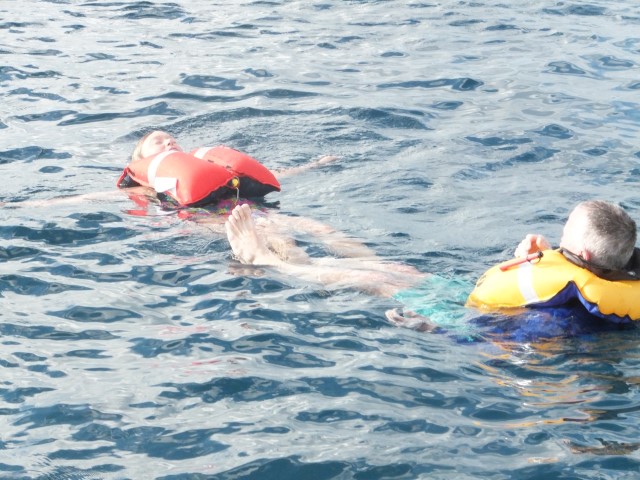There are a number of interesting MOB recovery systems in the world, such as the Sea Scoopa. However, many of them are unsuitable for prairie sailors like me. I need either a method that works with the kind of equipment that is standard on every charter boat, or a system that is compact and light enough to throw in my suitcase.
If I ever get to the place where I own a vessel, then my options for MOB recovery equipment open up a bit. But for now, the methods below seem the most practical.
Note: I am omitting from this discussion all methods that might involve removing a hypothermic individual from the water in a vertical position. The reasons for that have to do with circum-rescue collapse, which is discussed on the Home/Hypothermia page.
If water conditions are calm, and the MOB is still fit enough, then the simple method is the easiest: the casualty comes around to the stern and climbs up the
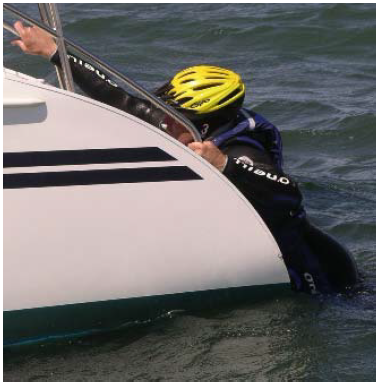
However, if there is significant wave action, any pounding of the stern could pose a lethal risk to a person in the water near the stern.
A better method to use if the MOB is still fit enough to assist in his own recovery is the
And by-the-by, notice how much freeboard this yacht has. Nobody, but nobody, is going to just lie down on deck and grab a passing MOB by the collar. Your boat-recovery strategy has got to be something that goes beyond "drag the casualty back on board" as you see in this video.
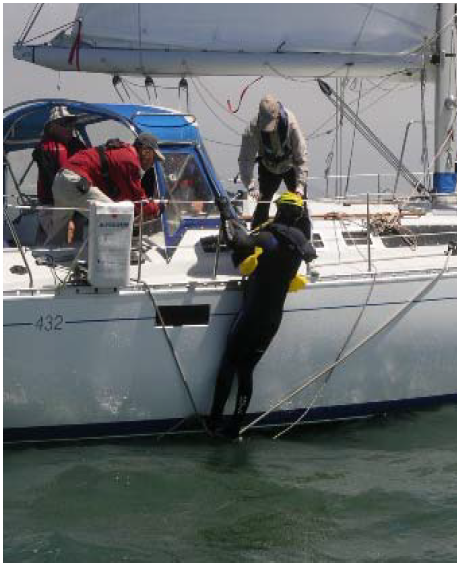
Now, if we want to learn to tack efficiently, we don't just read about it in a book or look at pictures on the web. We practice it ourselves. This is, or should be, doubly true with man overboard recovery. So during our January 2015 trip to the British Virgin Islands, we decided to test various ideas about MOB. We all practised getting into the boat by the elevator method...and it worked pretty well!
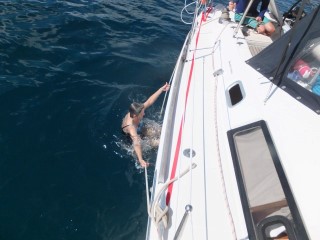
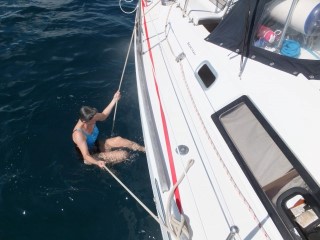
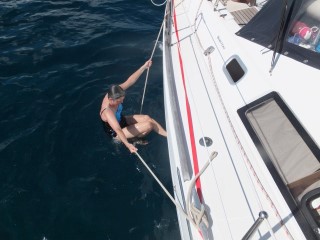
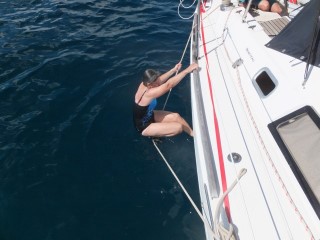
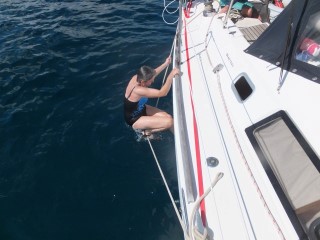

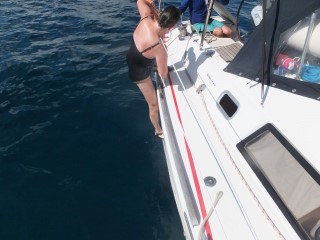
One method that did NOT work was the "brute force" method of just hauling the person up onto the swim platform or into the dinghy. In our case the swim platform was a little small for two rescuers and one casualty to share, so two of my crew tried to haul me into the dinghy. I was not, by the way, trying to simulate unconsciousness. Even with me kicking like crazy, they couldn't get me out of the water.

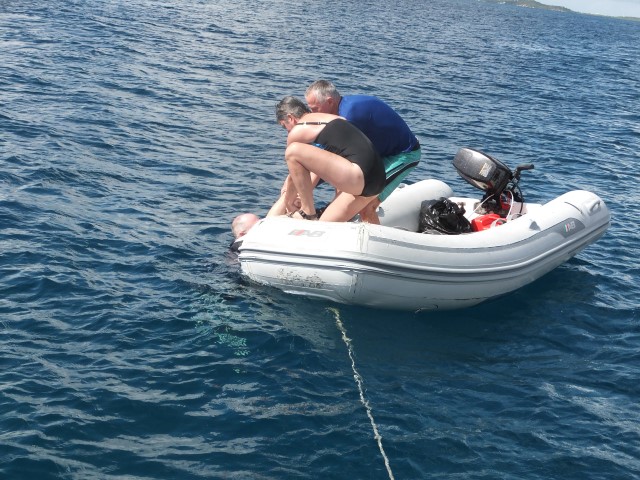


Once I got back home to Canada, it occurred to me that if we had found the valve to let the dinghy partially deflate, my crew may have been able to recover me. But frankly, this is not a technique we would have wanted to experiment with anyway. We
In the event of an actual MOB emergency, one could perhaps look for the valve...or just stick his knife into the dinghy. You would eventually have the dinghy sink...but better that than to lose a person's life.
If you are in the tropics, however (as we were when these photos were taken), drowning - and possibly sharks - are your only hazards. You just want to get him out of the water any way you can, as quickly as you can.
It is one of the unpleasant little ironies of sailing that when you get far enough south that you no longer have to worry about hypothermia, you must start to consider sharks.
2005 MOB Symposium
One of the resources you need to be aware of is the 2005 Crew Overboard Rescue Symposium.pdf document. A broad array of sailors got together in San Francisco Bay back in 2005 to actually test various theories of boat-handling as well as casualty-recovery. It is impossible to overstress how important this event has been to us over the past decade. There are so many who theorize about MOB recovery (I will not mention any by name, but Sail Canada comes to mind), who say "Do such-and-such" without ever trying it for themselves to discover that the technique taught will simply not
work .Those of us who are serious about boating safety need to adopt the motto of the Royal Society: 'Nullius in verba' which is translated as 'take nobody's word for it'.
So download this document and digest it. It has only one weakness: it is 10 years old. It does not take into account the "aha!" moment which has led to the "heave-to, sail-to, heave-to" technique of boat handling. Nor were they fully cognizant of all we have come to understand recently about hypothermia. That said, this is a must-read document.
Parbuckle Net
The word "parbuckle" is very uncommon in modern English, but it IS the word used to describe rolling something (like a barrel) up an incline (like the hull of a ship). There is no other word available in English to desribe this.
The 2005 Symposium document does mention the possibility of using a parbuckle net...though the net pictured here seems to be unavailable commercially. Likely, it is homemade...as up until very recently, there were no commercially made parbuckle nets available.
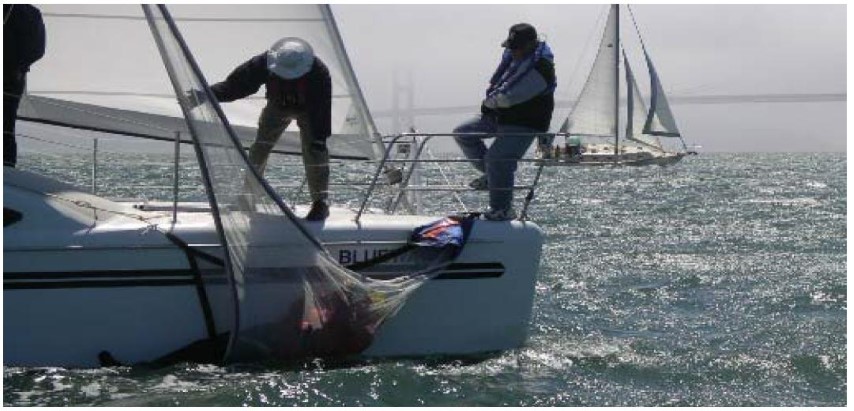
Parbuckling a casualty up the side of your vessel has two enormous advantages. First, it works even with a wholly unconscious or critically hypothermic casualty.
Second, it keeps the casualty horizontal, thereby reducing the risk of circum-rescue cardiac collapse.
Unless you plan to make your own parbuckle net from parachute cord, the very best option is the SOS Recovery Ladder, from SOS Marine in Australia. It is available in Canada from ca.Binnacle.com of Halifax.
The cost of the SOS Ladder is not dramatically more than what I spent tying my own parbuckle net out of parachute cord...and it is a much more professional piece of equipment in the end.
A further benefit is that at 7.2 pounds, it is small enough to throw in your suitcase if you are like me: a prairie sailor who always flys somewhere to charter a boat. It is lighter weight and smaller than a comparable home-made recovery net tied from parachute cord.
If your MOB is fit and conscious enough to use it, this can be used as a ladder. And in this capacity, you might find it helpful even if NOT an MOB casualty. Some sailboats you charter come with no swim platform at the stern, and no convenient way to reboard if you decide to go for a swim.
But if you do have an unconscious or hypothermic casualty who cannot assist in their own recovery, you can affix a halyard to the peak of the recovery net, maneuver your casualty into the bight of the net, and then just roll them up the side of the vessel. When they get up near deck level, you can wrestle them aboard. If they have a PFD on, it may be a little challenging to get them in under the lifelines...but at the very least, while you are doing this, they are in no danger at all of drowning, and their risk of serious injury due to hypothermia is dramatically reduced.
Update on the SOS Ladder This has not worked out as well as I had hoped. First, it needs to be rigged TAUT along the gunwale of the boat. If it is not taut, it can sag enough that you will never be able to roll a person up the side of the boat to the level of the deck.
To get it sufficiently taut, I had to rig a block and tackle arrangement leading to horn cleats fore and aft. Even when I practiced rigging the ladder repeatedly, the best time I could manage was 5 minutes and 17 seconds.
Particularly if I am single-handed, that is 5 minutes that I am away from the wheel, and where I am not actively attending to the casualty in the water.
The other piece of this is that if it takes
me 5+ minutes, after I have practiced my procedure repeatedly, there is no way my wife is going to be able to sort out the complexities of the block and tackle at all. So if I am the one to go in the water, good luck to my wife as she tries to fish me out.Second, once you get the person out of the water, such that you get no further advantage from the natural bouyancy of their body, rolling them up the side of the boat becomes the work of two men, even when using one of the big sheet winches to do the hauling. It would be completely beyond me to retrieve my wife from the water if I was on my own. And of course, she would even more trouble getting me out, since I am heavier of the two of us.
In consequence of these discoveries, I gave away the SOS Ladder I had purchased, and decided that my best hope was to somehow secure the casualty to the side of the boat, so they don't drift away. Further, anything I can do to lift at least a portion of their torso out of the water will increase their survival time in the face of hypothermia. While they are secured to the boat, which is hove-to, I can go down into the cabin and make a Mayday call to the Coast Guard. Then wait for them to come and take the casualty off my hands, and transport them to a hospital that has the equipment to help a hypothermic patient recover.
In summary, while the Heave-to, Sail-to approach to boat handling can get me back to the casualty, the task of retrieving my MOB back on board remains an unsolved problem. The best I can do is to attempt to make sure they don't drown or get separated from the boat, and call for the Coast Guard to come and assist me. I will not revise the rest of this web page at this time. But it is enormously disappointing for me to discover that after all these years, I still don't know how to get a casualty back on board.
Second Thoughts About My Second Thoughts Perhaps the SOS Ladder is still a worthwhile purchase, in that you CAN maneuver an unconscious casualty into it. Getting a bowline under the arms of an unconscious casualty could be next to impossible.
And even if you cannot roll the MOB all the way up the hull, and even if you cannot rig the SOS ladder securely to your gunwale, you can still get your casualty
partially out of the water, which will improve their survival time, as well as keeping them secure until the Coast Guard arrives.
If your casualty is seriously hypothermic, and you expect Coast Guard assistance within 20 minutes, you might keep the casualty in the cockpit. If it will be some time before you expect assistance, you will want to get the casualty down into the cabin to begin warming them up.
Because of what you know about hypothermia, you know that if the casualty is able to walk, you can let them do so...but slowly, and for only a moment to get down the companion way stairs. Then they should lie down again. You don't want them upright and active until they have warmed up a bit.
If they are mostly conscious, you can give the person a warm beverage to help warm them up from the inside out. Not TOO warm. The casualty will be less able than normal to recognize that something is so warm it must be sipped carefully to avoid scalding the throat on the way down.
You should try a sip whatever you plan to serve before handing it to the casualty, to ensure the temperature is right.
If he is mostly unconscious, wrap him in a sleeping bag.
But before you do this, wrap him in a plastic tarp - if you have one - to serve as a vapor barrier to protect against further evaporative cooling, and to keep the sleeping bag dry. A dry sleeping bag, of course, has much better insulating qualities than one that is wet.
